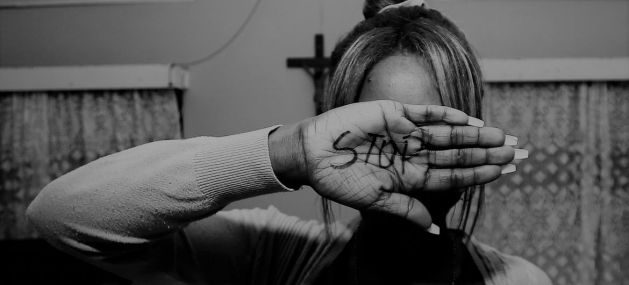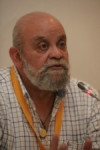Technology, Social Media Help Traffickers Hunt Their Victims, Enslave Them, Sell Their Organs
TRANSCEND MEMBERS, 8 Aug 2022
Baher Kamal | Human Wrongs Watch - TRANSCEND Media Service
3 Aug 2022 – Human beings have proved to be capable of producing innumerable practical inventions while much too often making the worst use of them. Take the case, per example, of how criminal groups heavily rely on digital platforms to trap and enslave their victims also for extracting and selling their organs.

Venezuelan migrant Manuela Molina (not her real name) was promised a decent job in Trinidad, but minutes after her arrival she was forced into a van and taken to a secret location. Credit: IOM Port of Spain
Yes, technology now dominates most of human activities and, surprisingly enough, it is now presented as the perfect life-saving solution for the smallest and poorest households worldwide. Simply, it has replaced the precious human knowledge, which has been acquired over thousands of years.
And technology is now utilised by the world’s biggest ‘warlords’ to bomb unarmed civilians with drones, also carrying nuclear heads.
Meanwhile, internet and digital platforms are used by criminal gangs to recruit, exploit and control the victims of their human trafficking lucrative business. Among other crimes, victims of trafficking are also targeted for “organ harvesting.”
No wonder then that the 2022 World Day Against Trafficking in Persons (30 July) has focused on the use and abuse of technology as a tool that can both enable and impede human trafficking.
What’s behind human trafficking?
“Conflicts, forced displacement, climate change, inequality and poverty, have left tens of millions of people around the world destitute, isolated and vulnerable,” said UN Secretary-General António Guterres ahead of World Day.
The COVID-19 pandemic has separated children and young people in general from their friends and peers, pushing them into spending more time alone and online, said Guterres.
“Human traffickers are taking advantage of these vulnerabilities, using sophisticated technology to identify, track, control and exploit victims.”
Slave markets, also in refugee camps
Obviously, given the clandestinity of these inhuman operations–and the negligent complicity of official authorities–, the number of victims is practically impossible to calculate.
The International Organization for Migration (IOM) estimates that the number of “detected” trafficked persons amounts to over 150,000. Other estimates talk about as many as one million.
More than 60% of known human trafficking victims over the last 15 years have been women and girls, most of them trafficked for sexual exploitation.
Meanwhile, the criminal gangs’ operations have been extended everywhere, even in refugee camps.
In the article: Slave Markets Open 24/7: Refugee Babies, Boys, Girls, Women, Men…, IPS reported that, in addition to slave selling and buying deals in public squares, as reported time ago in ‘liberated’ Libya, a widespread exploitation of men, women, and children has been carried out for years at refugee camps worldwide.
One of them is a Malawi refugee camp, where such inhumane practice has been reported by the UN Office of Drugs and Crime (UNODC) and the Malawian Police Service.
“I even witnessed a kind of Sunday market, where people come to buy children who were then exploited in situations of forced labour and prostitution,” said UNODC’s Maxwell Matewere.
The camp is also being used as a hub for the processing of victims of human trafficking. Traffickers recruit victims in their home country under false pretences, arrange for them to cross the border into Malawi and enter the camp.
Many other refugee camps, as it is the case of the Za’atari camp in Jordan, where tens of thousands of Syrian refugees are located once they had to flee the 11-years long devastating war on their country, are also suspected of being stage for human trafficking. And the list goes on.
The Dark Web
Often using the so-called “dark web”, online platforms allow criminals to recruit people with false promises, informs the UN, adding that technology anonymously allows dangerous and degrading content that fuels human trafficking, including the sexual exploitation of children.
On this, the UNODC explains that as the world continues to transform digitally, internet technologies are increasingly being used for the facilitation of trafficking in persons.
With the rise of new technologies, some traffickers have adapted their modus operandi for cyberspace by integrating technology and taking advantage of digital platforms to advertise, recruit and exploit victims.
Recruited through social media
Everyday, digital platforms are used by traffickers to advertise deceptive job offers and to market exploitative services to potential paying customers, explains UNODC.
“Victims are recruited through social media, with traffickers taking advantage of publicly available personal information and the anonymity of online spaces to contact victims.”
Patterns of exploitation have been transformed by digital platforms, as webcams and live streams have created new forms of exploitation and reduced the need for transportation and transfer of victims.
Trafficking in armed conflicts
A group of UN-appointed independent human rights experts, known as Special Rapporteurs, has recentlyunderscored that the international community must “strengthen prevention and accountability for trafficking in persons in conflict situations”.
Women and girls, particularly those who are displaced, are disproportionately affected by trafficking in persons for the purpose of sexual exploitation, forced and child marriage, forced labour and domestic servitude, they warned.
“These risks of exploitation, occurring in times of crisis, are not new. They are linked to and stem from existing, structural inequalities, often based on intersectional identities, gender-based discrimination and violence, racism, poverty and weaknesses in child protection systems,” the experts said.
Structural inequalities
According to the independent human rights experts, refugees, migrants, internally displaced and Stateless persons are particularly at risk of attacks and abductions that lead to trafficking.
And the dangers are increased by continued restrictions on protection and assistance, limited resettlement and family reunification, inadequate labour safeguards and restrictive migration policies.
“Such structural inequalities are exacerbated in the periods before, during and after conflicts, and disproportionately affect children”, they added.
Targeting schools
Despite links between armed group activities and human trafficking – particularly targeting children – accountability “remains low and prevention is weak,” the UN Special Rapporteurs underlined.
Child trafficking – with schools often targeted – is linked to the grave violations against children in situations of armed conflict, including recruitment and use, abductions and sexual violence, they said.
“Sexual violence against children persists, and often leads to trafficking for purposes of sexual exploitation, sexual slavery, forced pregnancy and forced marriage, as well as forced labour and domestic servitude”.
Organ harvesting
The independent human rights experts also highlighted that in conflict situations, organ harvesting trafficking is another concern, along with law enforcement’s inability to regulate and control armed groups and other traffickers’ finances – domestically and across borders.
“We have seen what can be achieved through coordinated action and a political will to prevent trafficking in conflict situations,” said the group of Special Rapporteurs, advocating for international protection, family reunification and expanded resettlement and planned relocation opportunities.
Special Rapporteurs and independent experts are appointed by the Geneva-based UN Human Rights Council to examine and report back on a specific human rights theme or a country’s situation. The positions are honorary, and the experts are not paid for their work.
Protection services ‘severely lacking’
The UN refugee agency, UNHCR, on 29 July warned that protection services for refugees and migrants making perilous journeys from the Sahel and Horn of Africa towards North Africa and Europe, including survivors of human trafficking, are “severely lacking”.
“Some victims are left to die in the desert, others suffer repeated sexual and gender-based violence, kidnappings for ransom, torture, and many forms of physical and psychological abuse.”
All the above is just another tragic evidence of how big is the ‘dark web’ of the world’s so-called decision-makers.
_____________________________________________
 Baher Kamal, a member of the TRANSCEND Network for Peace Development Environment, is an Egyptian-born, Spanish national, secular journalist, with over 45 years of professional experience — from reporter to special envoy to chief editor of national dailies and an international news agency. Baher is former Senior Advisor to the Director General of the international news agency IPS (Inter Press Service) and he also contributed to prestigious magazines such as TRANSCEND Media Service, GEO, Muy Interesante, and Natura, Spain. He is also publisher and editor of Human Wrongs Watch.
Baher Kamal, a member of the TRANSCEND Network for Peace Development Environment, is an Egyptian-born, Spanish national, secular journalist, with over 45 years of professional experience — from reporter to special envoy to chief editor of national dailies and an international news agency. Baher is former Senior Advisor to the Director General of the international news agency IPS (Inter Press Service) and he also contributed to prestigious magazines such as TRANSCEND Media Service, GEO, Muy Interesante, and Natura, Spain. He is also publisher and editor of Human Wrongs Watch.
Go to Original – human-wrongs-watch.net
Tags: Child labor, Child slavery, Human Traffic, Internet, Slave labor, Slavery, Social media, Technology
DISCLAIMER: The statements, views and opinions expressed in pieces republished here are solely those of the authors and do not necessarily represent those of TMS. In accordance with title 17 U.S.C. section 107, this material is distributed without profit to those who have expressed a prior interest in receiving the included information for research and educational purposes. TMS has no affiliation whatsoever with the originator of this article nor is TMS endorsed or sponsored by the originator. “GO TO ORIGINAL” links are provided as a convenience to our readers and allow for verification of authenticity. However, as originating pages are often updated by their originating host sites, the versions posted may not match the versions our readers view when clicking the “GO TO ORIGINAL” links. This site contains copyrighted material the use of which has not always been specifically authorized by the copyright owner. We are making such material available in our efforts to advance understanding of environmental, political, human rights, economic, democracy, scientific, and social justice issues, etc. We believe this constitutes a ‘fair use’ of any such copyrighted material as provided for in section 107 of the US Copyright Law. In accordance with Title 17 U.S.C. Section 107, the material on this site is distributed without profit to those who have expressed a prior interest in receiving the included information for research and educational purposes. For more information go to: http://www.law.cornell.edu/uscode/17/107.shtml. If you wish to use copyrighted material from this site for purposes of your own that go beyond ‘fair use’, you must obtain permission from the copyright owner.